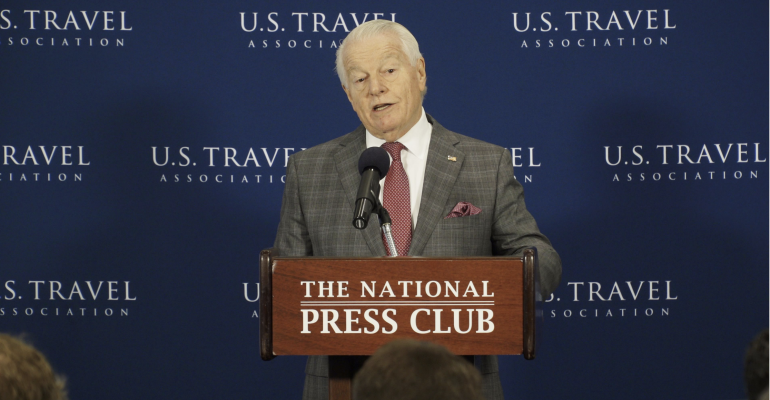The U.S. Travel Association, which represents more than 1,100 member organizations across the $1.5 trillion U.S. travel industry, announced in late July that Roger Dow will retire as president and CEO on July 31, 2022 after 17 years at the helm.
But before he goes, Dow has his hands full. He’ll be tackling the travel-related challenges stemming from the Covid pandemic—including those affecting the $125 billion meeting, convention, and trade-show business.
According to USTA, the business-events industry lost 76 percent of its revenue, or $97 billion, in 2020. And while the availability of Covid vaccines had started to reinvigorate in-person events by late spring of this year, the momentum proved brief once the delta variant hit hard among the 40 percent of unvaccinated Americans, and even affected many vaccinated Americans.
For instance, the World Pet Association’s SuperZoo show in Las Vegas drew nearly 12,000 people in mid-August—but since then, cancellations of large events are once again rising. In addition, many cities are imposing vaccine mandates for event participants or simply forbidding any large events for the time being. (For the most recent example of this, read about Oahu’s new rules here.)
To keep the business-events sector top of mind with state legislators and the U.S. Congress, Dow and U.S. Travel established the Meetings Mean Business coalition in 2009, during the “Great Recession,” to promote the value of face-to-face business events. And in June 2021, USTA launched the Let's Meet There initiative not only to reinforce the messages of MMB but also to inspire future group-business travel following the steep drop in face-to-face events due to Covid.
As part of this effort, Dow and USTA have promoted a white paper featuring science-based protocols that allow for safer in-person events while also speaking out against the continued closure of the land border between the U.S. and Canada. The association also promotes vaccination as a major component for reviving in-person business events as quickly as possible.
MeetingsNet caught up to Dow in late August to ask his thoughts on what can be done by himself, USTA, and anyone involved in the planning and execution of business events in order to speed their recovery.
MeetingsNet: Between now and when you retire in July 2022, what do you think you and USTA could advocate for that would most help the domestic business-events sector?
Roger Dow: First and foremost, we strongly encourage everyone to get a vaccine. It’s the fastest path to normalcy, including for widespread travel. We are also urging the CDC and federal public-health authorities to distinguish professional meetings and events from other so-called “large gatherings,” given the layers of health safety that can be implemented in these highly controlled settings where business gets done.
Another area of advocacy is our push to safely restart international inbound travel, beginning with vaccinated individuals from countries with high vaccination rates and low case counts, like Canada as well as parts of Europe and the U.K. We have been vocal about reopening the northern land border to vaccinated Canadians, just as the Canadian government has done for U.S. travelers. The U.S. should reciprocate this action.
We are also urging the Biden administration to establish an air corridor between the U.S. and the U.K., followed by other European nations that meet specific health criteria in order to get trans-Atlantic travel reestablished. It can’t happen soon enough.
We must manage the environment we are in as best possible while rebuilding travel overall, a domestic industry that lost nearly $500 billion in spending and 3 million direct jobs last year alone.
MeetingsNet: What can buyers as well as hotels and other suppliers in the meetings and events industry do to help set the right conditions for in-person events to come back quickly?
Roger Dow: That’s a great question because there are many steps we can take to set the right conditions—doing it with a layered approach to health and safety. I encourage everyone to follow the evidence-based recommendations [found in the white paper] for resuming in-person meetings and events that Ohio State University scientists produced.
A few months ago, we worked with the university’s chief wellness officer on guidance specific to this travel sector that was derived from trusted sources, such as the CDC and JAMA. Ohio State identified practices such as mask usage, physical distancing, ventilation, food & beverage set-ups, and even lifestyle behaviors that we can employ to restart face-to-face meetings and conferences and get back to our pre-pandemic ways of doing business. (Read about specific recommendations on MeetingsNet.)
U.S. Travel and the Meetings Mean Business coalition are working in lockstep under the “Let’s Meet There” banner to get this word out, not only throughout our industry and its suppliers, but to business leaders around the country who are making decisions about future business travel.





